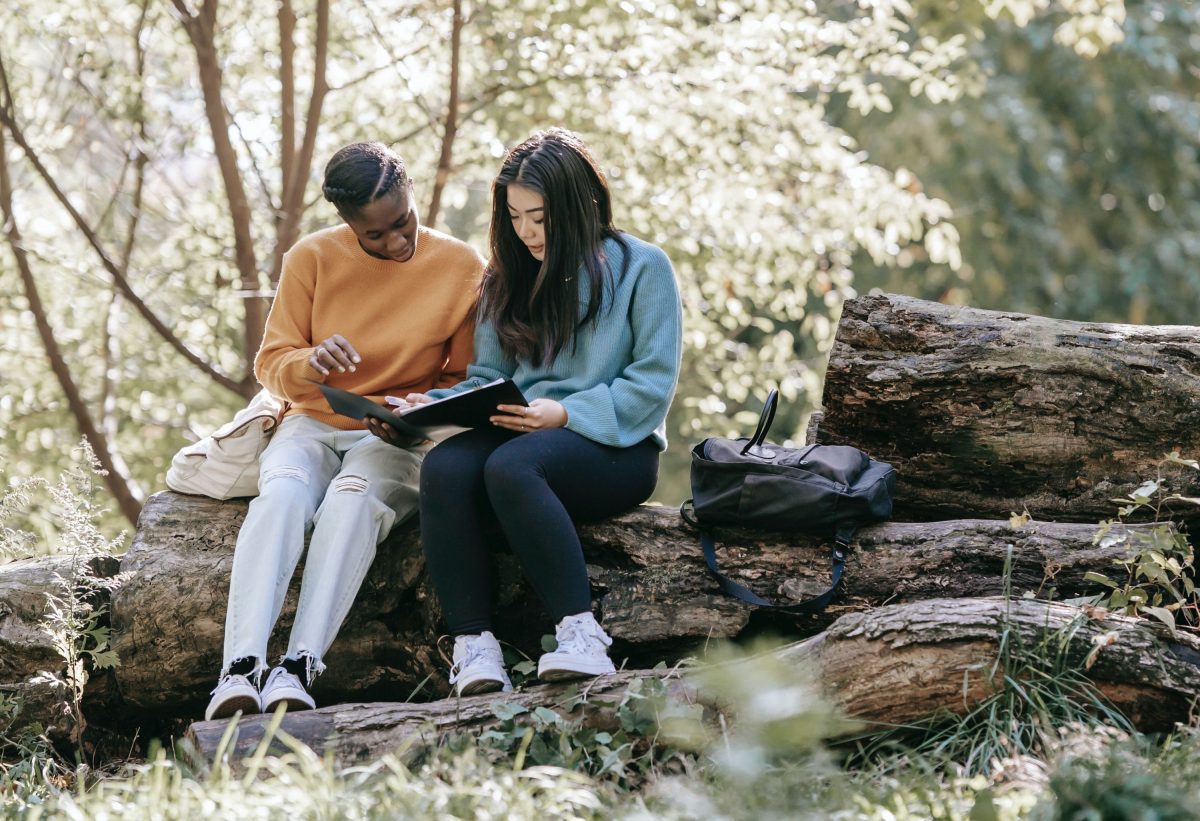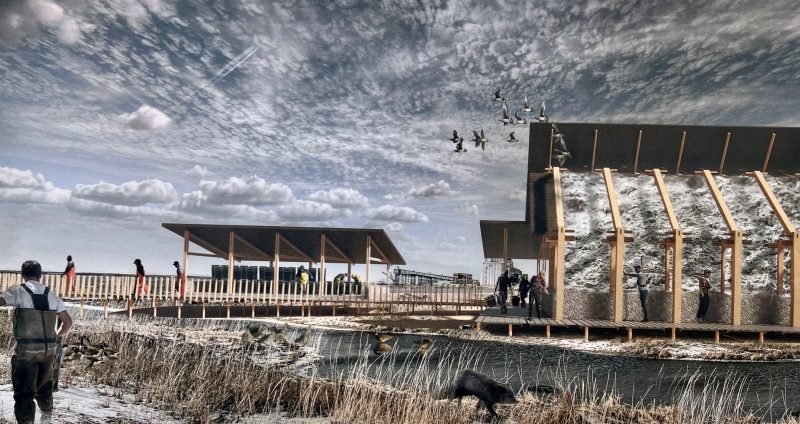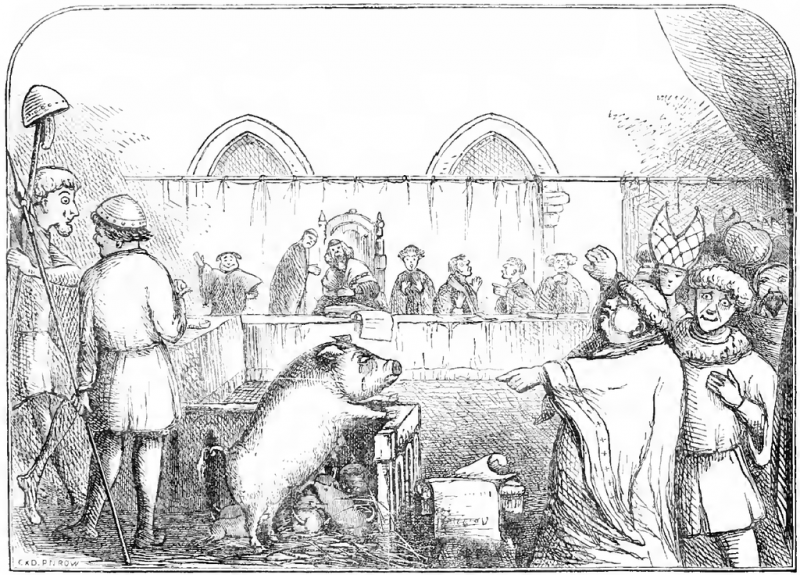
Many courses are doing things differently, taking students into nature to learn from the natural world. // Image: Pexels, Charlotte May
Eight UM courses that’ll get you hands-on with climate change and make you a better Earth citizen
So you want to be a better Earth citizen. Good. We have a course for that. Lots of them, really.
Here are eight enthralling ones teaching students how to view and do things differently, from incorporating Traditional Knowledges into building designs so they are kinder to worms, to learning how the right entrepreneurial mindset can help protect animals.
Architecture serves all, not just humans
Course: Nature as Mentor, Faculty of Architecture

A rendering of Zebra Muscle Processing Facility by student Dominico Obmerga for the course Nature as Mentor, a course that challenges students to think how architecture can imagine a future with the natural world.
In the first term you design a project for extreme environments on Mars and in Churchill. In the second term you combine Traditional Knowledge with climate data to expand your views of climate change and help you anticipate the environmental changes to come so you can build a better community.
“The recurring theme that comes up in this course is how to design architecture that forms a reciprocal exchange with the ‘more-than-human-world’. Architecture is not just for humans. This speaks to traditional Indigenous ways of thinking about responsibility and giving back—to this idea of sympoiesis, or ‘working with’,” associate professor Lancelot Coar says of the course he co-teaches with assistant professor Mercedes Garcia-Holguera.
“And a lot of the conversations students have is around the innovative ways they can create buildings that provide habitat for other creatures, from worms to crabs to fish. It’s the idea that Architecture should be built to serve all, not just humans.”
Design studios are taught all over the world, but this fourth-year undergrad studio takes the unique approach of working with climate data and Traditional Knowledge provided through collaborations with the Prairie Climate Centre and the Pacific Institute for Climate solutions.
We’re focused on training students to dream and be imaginative in thinking about how architecture can co-imagine a future with the natural world rather than just building on it as has been done for too long,” Coar says.
Social leg in this stool of sustainability
Course: Impact of Engineering on the Environment, Price Faculty of Engineering
The very first thing you do is audit your household’s greenhouse gas emissions, right down to the yogurt in the fridge. Then, you think about how a few changes could reduce emissions. And then you’ll ponder if someone in another part of the world could do the same.
It’s perhaps the closest an engineering course gets to teaching empathy as you learn to view the built world through the lenses of social, economic and environmental sustainability.
For professor Nazim Cicek, who has been teaching a version of this course – now mandatory for second-year students – for 23 years, the “social leg in this stool of sustainability” has become one of the more engaging for his students.
“The course has changed to include a lot more on public engagement, specifically with Indigenous communities and how to meaningfully engage and learn from Elders and anyone else with a close connection to the land because such knowledge is crucial. You need Traditional Knowledge and western scientific knowledge together to understand and recognize changes…. We have these great discussions about Reconciliation and Indigenous land rights and by the time we reach the end of the course, students have a broader awareness of social implications of our work, and how, to make something sustainable, it has to benefit all parties involved.”
Attention citizens of Earth
Course: Earth: A User’s Guide, Clayton H. Riddell Faculty of Earth, Environment, and Resources

Did you read the manual? // Image: NASA
A classic first-year course for those wanting to know a bit more about how to run a planetary system. It caters to students who are not familiar with Environmental Sciences and gives them great exposure to the different aspects of the environment. Associate professor Mary Benbow authored the course years ago, so that it captures a balanced view of the Riddell Faculty’s units, from acknowledging human needs to the potential impacts or our actions. The goal is to have students leave as informed Earth citizens.
What gets students chatting the most in class? Hydrogen. “Hydrogen as a source of fuel seems to appeal to many students,” says this term’s instructor Johny Stephen. “And one thing that struck me was how students who have a farming background – either farmers themselves or come from a family of farmers – were worried about the changing weather patterns. They had some very helpful insights into changing agricultural practices due to climate change. Other students also learned a lot from their experiences.”
Hope and possibilities in the face of Climate Change
Course: Ecology and Design 2, Faculty of Architecture
If you’re a fan of Aaron Sorkin’s famed “walk and talks” then you’ll love this course taught by associate professor Brenda Brown. On one of the first days of the course a walk-and-lecture in a Winnipeg landscape focuses on layered non-human and human systems at work providing students with a multi-pronged view ecology and design. And Brown has designed two other major projects she flips between depending on the season to do this.
Warm weather (fall term): choose a small, say 3×3 or 5×5 meter space and observe it on two different scales, every week at the same time of day. Then, design something that draws people’s attention to the phenomenon observed. Cold weather (winter term): imagine and design an animal that fits into an existing or imagined landscape ecosystem. Often this is a hybrid animal of some kind, Brown says, but by considering the animal’s anatomy, physiology, habitat, behaviors, trophic relationships and lifespan, students better understand the interrelationships at work in landscape ecosystems.
“I don’t think I have to remind students of climate change” she says with a laugh. “I think what I’ve been more conscious of lately is offering hope. I seek out varied thoughtful and meaningful writings and design examples. Part of what I’m doing is laying out relationships of social problems to ecological problems and considering what that might mean in terms of landscape design and planning. It’s not that it’s a sad course or anything, but I have been more conscious of the importance of making sure there are good things, positive things, for students to accentuate. Possibilities.”
Hold your horses
Course: Animals and the law, Faculty of Law

Illustration from Chambers Book of Days depicting a sow and her piglets being tried for the murder of a child in 1457. The sow was found guilty and the piglets were acquitted.
What legal rights do geese on our campus have and what rights does the university have in protecting people from goose attacks? Why does Canada offer dogs more legal protections than the pig, a creature with perhaps greater intelligence? What rights befall an animal that moved to a new location because of climate change? What is a domestic animal and what is wildlife, and for that matter, if a wolf mated with a dog, is the progeny domestic or wild?
If you take professor Mary Shariff’s class you will ask many more questions as your personal philosophies collide with the law. Over the course you learn about the chronology of laws surrounding animals, including biblical views of animals as property and how animals were once tried for their deviance in the Middle Ages. You ponder our legal definitions. You question if our current laws and regulations are upholding our duties and obligations to incorporate Indigenous perspectives of animals under the Constitution.
“I love the practical components. We sometimes bring in a student from the Natural Resources Institute, and since they are in the field looking at animals from a management perspective, they share their practical experience, and the law students can share the legal limits and opportunities. It’s super neat to watch,” says Shariff. “My favorite part is when we dig apart why people hold the beliefs that they do—and we all learn from that. Just unpacking why we hold these perspectives and then say, ‘OK, how does the law approach what you think?’ It really gets people talking.”
Kale-ifornia dreaming in your backyard
Course: Urban agriculture, Faculty of Agricultural and Food Sciences
This first-year class is filled with students from across campus eager to learn how to start, tend, harvest and store an urban garden and its bounty. You’ll learn about vertical and raised gardens, greenhouses and hydroponics and apply this knowledge in, say, designing a garden for a school. Big ideas are encouraged: This year a local entrepreneur spoke to the class about his invention wherein he can mail a hydroponics system to anyone using an 8×10 envelope. The class took hydroponics for a test drive and grew lettuce – without any soil. Students also work in groups to grow and keep alive edible plants in a greenhouse throughout the course. (Did you know you can eat daylilies?)
“It’s an interesting course to teach in that you’re teaching to a real range of student skill levels. I think there’s something in this course for everyone,” says Yvonne Lawley, assistant professor in Plant Science. “We connect with practical, experience-based learning through different projects…. Environmentalism is at the heart of the course and drives a lot of people’s interest in in local food.”
Life moves pretty fast
Course: Ecological Crisis, Work and Capitalism Today, Faculty of Arts
Bringing ecology to sociology and labour studies. Every second year, associate professor David Camfield, coordinator of the labour studies program, teaches a special topics course that gives students a taste of how Earth System science and social science can come together, providing them with a richer view of what’s causing the complex ecological crisis, including climate change. But “life moves pretty fast” (thank you Ferris Bueller), so this course stays dynamic and fresh.
“I first taught a version of this course in 2019 and I’ve had to revise it to address the COVID-19 pandemic as another aspect of the global ecological crisis,” Camfield says.
The fast-paced course tackles question of great relevance to students, such as what distinct challenges young people experience in Canada and similar societies. And it asks, to what extent are today’s ecological and societal crises interconnected?
Solving global issues through imagination and debate
Course: Introduction to Entrepreneurship, I.H. Asper School of Business
Send in the big-picture, risk-tolerant, dreamers. This entrepreneurship course steps through environmental and social paradigms by having students engage with issues as social entrepreneurs. Taught this year by a fourth-year PhD student Li Yu, students are challenged to find viable solutions to everyday wicked issues such as water scarcity, child labor and animal cruelty. Students imagine and debate how they could solve these problems by developing some innovative ideas.
“I try to prep students to think about social and environmental issues and to try various ways to account for social and environmental changes,” Yu said.






